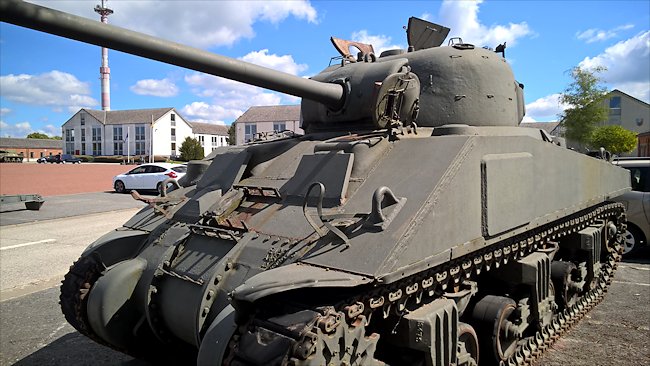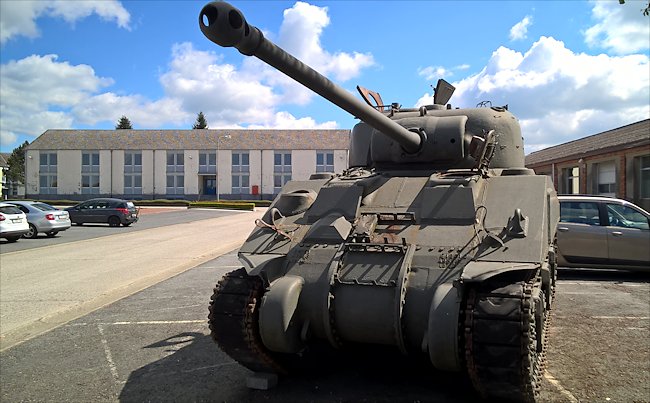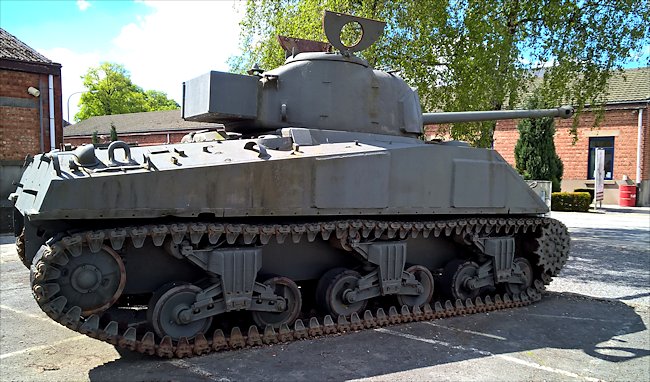M4A4 Sherman Firefly 17pdr Tank
This Firefly was sold to the Belgium Army after WW2 and used at the School of Armour in Leopoldsburg. British Sherman Firefly Tanks saw action in the WW2 Battle of the Bulge. This surviving Sherman Firefly is now kept at the Bastogne Barracks in Belgium. Chassis number SN 16912. Belgium Army number WD T232568

This restored M4A4 Sherman Firefly 17pdr Vc Tank is exhibited at the Bastogne Barracks in Belgium.
Location
The Bastogne Barracks can be found at 40 Rue de la Roche (N834) in Bastogne just north west of the city centre. They open at 10am and close at 4pm. You really need to get there by 2pm as there is a lot to see. It is an operational military camp with a tank restoration centre attached. You have to wait to go on a guided tour. You cannot wander around on your own. The only day it is closed is Monday. Many of the tanks have been restored to running condition. Have a look at their Facebook page for information about new events.

This restored M4A4 Sherman Firefly 17pdr Vc Tank is exhibited at the Bastogne Barracks in Belgium.
Specifications
The M4A4 Sherman Tank was powered by a Chrysler A57 multibank petrol engine. The Sherman tank hull had to be lengthened to enable the engine to fit. It produced 470 hp. The tank had a top road speed of 30 mph (48 km/h). It had an operational range of around 120 miles (193 km). The tank had a crew of five, commander, driver, gunner, loader and co-driver/machine gunner. Its armour thickness ranged for 25 mm to 75 mm. Additional plate armour was welded on the front of the Firefly in front of the driver and co-driver's position. Amour plates were also welded to the side of the tanks hull to protect the crew and the ammo storage bins.
It was armed with the powerful British Ordinance Quick Firing OQF 17 pounder long barrelled high velocity gun (76.2mm) that could penetrate the armour of both the German Tiger and Panther tank. It did not have a hull mounted machine gun. A .30cal (7.62mm) Browning M1919 machine gun was installed next to the main gun in the turret. A .50cal (12.7mm) Browning Machine gun could be fitted to a mount on top of the turret.

This restored M4A4 Sherman Firefly 17pdr Vc Tank is exhibited at the Bastogne Barracks in Belgium.
The Firefly's APDS shells
The British had a more sophisticated armor piercing shell than the Germans in 1944 It was the Armor Piercing Discarding Sabot (APDS), the sub-caliber shot was carried in an aluminum shoe (or sabot) which detached itself after leaving the gun muzzle. Increases in muzzle velocity were highly significant when a comparison of the penetrative powers of the British 17pdr (76.2 mm) and the German 88mm against homogenous armor at 30° to normal.
The 17pdr APDS shell could penetrate 170mm of armour at a 1km range compared with only 103mm penetration at the same distance for the German 88mm APCR shell. The thing to remember that although the German shell was not as efficient as the British ammunition it was still enough to penetrate the armour of all Allied armoured vehicles in Normandy 1944.
The British OQF 17-pounder was the only gun in Allied service which had a reasonable chance of penetrating the latest German AFVs at normal battlefield ranges, that is, up to 1000 meters.
Hence the priority attached by many British soldiers to equipping a percentage of their tanks with this gun before they invaded Western Europe in 1944, and their horror at being thwarted at every step to fit this gun to the Sherman. For in autumn 1943 the Americans shelved development of T20, the tank intended as Sherman's successor but armed with a 76.2 mm gun that was inferior to the British version.
The US 76.2 mm, which was being fitted to the latest mark of Sherman, was also inferior as an armor penetrator to the British 57 mm gun with APDS then currently arming Cromwell, the latest (and already obsolete) British cruiser tank. It was, indeed, fortunate for the British, and indirectly the Americans, that a handful of determined British officers managed, towards the end of 1943, to demonstrate the feasibility of mounting the 17 pdr in a Sherman.
They were just in time to force through enough conversions to build what became known as Firefly Sherman which in Normandy, that summer, would just hold the balance against the Tigers, Panthers and such powerful SP guns as the 46 ton Jagdpanther with its 71 caliber 88 mm gun. Yet, in cancelling T20 development and opting to concentrate instead on vast production of the obsolescent 75mm Shermans and an up gunned and up-armored Jumbo and Easy Eight Shermans, the Americans deliberately chose a policy of quantity versus quality — which was tant-amount to gambling on the lives and morale of Allied crews pitted against superior enemy tanks and tank destroyers.
Read more in these two tank books

